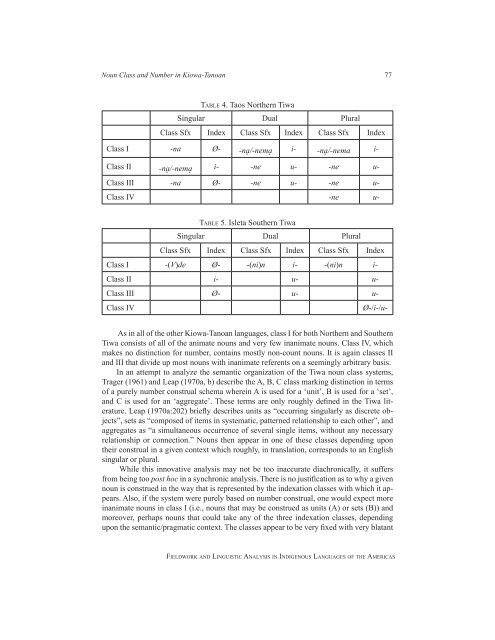Fieldwork and Linguistic Analysis in Indigenous ... - ScholarSpace
Fieldwork and Linguistic Analysis in Indigenous ... - ScholarSpace
Fieldwork and Linguistic Analysis in Indigenous ... - ScholarSpace
You also want an ePaper? Increase the reach of your titles
YUMPU automatically turns print PDFs into web optimized ePapers that Google loves.
Noun Class <strong>and</strong> Number <strong>in</strong> Kiowa-Tanoan 77<br />
table 4. Taos Northern Tiwa<br />
S<strong>in</strong>gular Dual Plural<br />
Class Sfx Index Class Sfx Index Class Sfx Index<br />
Class I -na Ø- -ną/-nemą i- -ną/-nema i-<br />
Class II -ną/-nemą i- -ne u- -ne u-<br />
Class III -na Ø- -ne u- -ne u-<br />
Class IV -ne u-<br />
table 5. Isleta Southern Tiwa<br />
S<strong>in</strong>gular Dual Plural<br />
Class Sfx Index Class Sfx Index Class Sfx Index<br />
Class I -(V)de Ø- -(ni)n i- -(ni)n i-<br />
Class II i- u- u-<br />
Class III Ø- u- u-<br />
Class IV Ø-/i-/u-<br />
As <strong>in</strong> all of the other Kiowa-Tanoan languages, class I for both Northern <strong>and</strong> Southern<br />
Tiwa consists of all of the animate nouns <strong>and</strong> very few <strong>in</strong>animate nouns. Class IV, which<br />
makes no dist<strong>in</strong>ction for number, conta<strong>in</strong>s mostly non-count nouns. It is aga<strong>in</strong> classes II<br />
<strong>and</strong> III that divide up most nouns with <strong>in</strong>animate referents on a seem<strong>in</strong>gly arbitrary basis.<br />
In an attempt to analyze the semantic organization of the Tiwa noun class systems,<br />
Trager (1961) <strong>and</strong> Leap (1970a, b) describe the A, B, C class mark<strong>in</strong>g dist<strong>in</strong>ction <strong>in</strong> terms<br />
of a purely number construal schema where<strong>in</strong> A is used for a ‘unit’, B is used for a ‘set’,<br />
<strong>and</strong> C is used for an ‘aggregate’. These terms are only roughly def<strong>in</strong>ed <strong>in</strong> the Tiwa literature.<br />
Leap (1970a:202) briefly describes units as “occurr<strong>in</strong>g s<strong>in</strong>gularly as discrete objects”,<br />
sets as “composed of items <strong>in</strong> systematic, patterned relationship to each other”, <strong>and</strong><br />
aggregates as “a simultaneous occurrence of several s<strong>in</strong>gle items, without any necessary<br />
relationship or connection.” Nouns then appear <strong>in</strong> one of these classes depend<strong>in</strong>g upon<br />
their construal <strong>in</strong> a given context which roughly, <strong>in</strong> translation, corresponds to an English<br />
s<strong>in</strong>gular or plural.<br />
While this <strong>in</strong>novative analysis may not be too <strong>in</strong>accurate diachronically, it suffers<br />
from be<strong>in</strong>g too post hoc <strong>in</strong> a synchronic analysis. There is no justification as to why a given<br />
noun is construed <strong>in</strong> the way that is represented by the <strong>in</strong>dexation classes with which it appears.<br />
Also, if the system were purely based on number construal, one would expect more<br />
<strong>in</strong>animate nouns <strong>in</strong> class I (i.e., nouns that may be construed as units (A) or sets (B)) <strong>and</strong><br />
moreover, perhaps nouns that could take any of the three <strong>in</strong>dexation classes, depend<strong>in</strong>g<br />
upon the semantic/pragmatic context. The classes appear to be very fixed with very blatant<br />
fieldwork <strong>and</strong> l<strong>in</strong>guistic analysis <strong>in</strong> <strong>in</strong>digenous languages of the americas

















